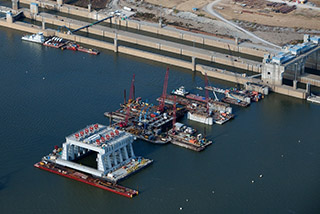Jammed tow traffic on the Ohio River should be easing this weekend with the completion of maintenance at the Corps of Engineers’ aged Lock 52 on the busiest stretch of the river.
The delay involving more than 800 vessels is just the most epic example of longstanding congestion on the river and never-ending maintenance issues with Locks 52 and 53, part of the Corps’ original 1929 infrastructure on the Illinois side just above the confluence of the Ohio and Mississippi.
The $3 billion Olmsted Lock and Dam project will replace the old locks, but in the meantime the deteriorating structures still need repairs, from cracked walls to damage from repeated barge impacts.
“On Sept. 26 the lock will reopen, so we’ll see traffic start to move…Things are going to be looking up, come tomorrow,” Carol Labashosky, a spokeswoman for the Corps of Engineers Louisville, Ky. district office, said Friday. As of Sept. 23 there were 73 tows in the river waiting to lock through, she said.
Repairs to the lock’s 1,200’ chamber took several weeks. Because it’s still low-water season, the Corps will next undertake fixing the 600’ chamber, from Oct. 5 to Oct. 19, but that work should not cause the same kind of delays, Labashosky said.
“That repair work is to repair and stabilize the inner guide wall of the chamber,” Labashosky said. Altogether, “this really needs to be done. The structures are so antiquated,” she said.
The river backup underscores longstanding issues for the inland waterways that were highlighted in a June report by the National Research Council, which called for a new user fee on barge operators to help the Corps of Engineers catch up on maintenance.
Drafted by experts from government agencies, the private sector and universities, the report said the Corps needs a better plan for ensuring that limited resources are directed toward locks and facilities that are most critical to maintaining system reliability and performance.
To help pay for it, the report suggested that besides a fuel tax paid by barge operators, a new direct user fee be imposed on commercial traffic to help pay for the $650 million annual operations and maintenance budget, now fully three-quarters of the Corps’ inland spending.
“In a climate of constrained federal funds and with O&M becoming a greater part of the inland navigation budget, it is reasonable to examine whether beneficiaries could help pay for the system to increase revenues for the system and improve economic efficiency,” according to the report, a product of an 18-month study by the NRC’s transportation Research Board.
That part of the report was not welcomed by industry. Imposing a new user fee on barge operators would be “highly predatory,” and run counter to the Obama administration’s policy of maximizing U.S. exports, said Mike Toohey, CEO of the Waterways Council Inc.
Low transportation costs are part of what makes U.S. commodities like grain so competitive in global markets. Locks 52 and 53 on the lower Ohio have long been a choke point in the system, with delays of up to three days even when everything is operational, according to the Corps.
Traffic delays raise costs for both shippers and their customers – like corn farmers, who are moving their harvests to market and already looking at prices fluctuating with changing forecasts. The U.S. Department of Agriculture slightly lowered its predictions for the 2015-2016 season to 13.585 billion bu., but that would still be the third-highest harvest on record.




